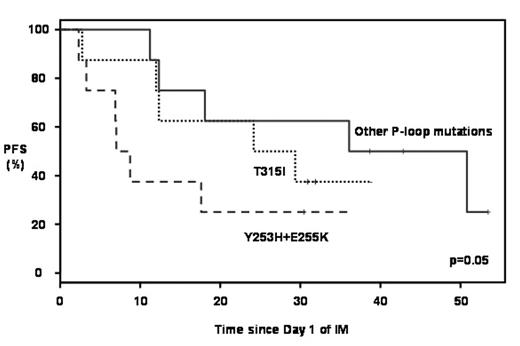Abstract
In CML, the most frequent mechanism responsible for IM resistance is the onset of BCR-ABL mutations. Mutations interfering with IM binding to the ABL-kinase domain that restore the tyrosine kinase activity of BCR-ABL (T315I and P-loop mutations) are of poor prognosis. In a retrospective analysis, we analysed the features and clinical outcomes of 50 CML patients and presenting IM resistance, and harbouring 33 P-loop (1 patient had mutations) [Group 1 (G1)] and 18 T315I mutations [Group 2 (G2)] detected by direct sequencing. Twenty-eight patients were in chronic phase (CP), 12 in accelerated phase and 9 in blastic phase when IM was started, with no difference between P-loop and T315I groups. There were 23 M and 9 F, with a median age of 53 (13–74) for G1; and 14 M and 4 F, with a median age of 52 (28–70) for G2. The median duration of IM was 25 Mo (2.4–50) for G1 and 20 (0.5–145) for G2 (p=ns). The duration of IFN prior to IM was equivalent for both groups (12 Mo (0–86) for G1 vs 10 Mo (4–131) for G2, p=ns). The median interval between diagnosis and day 1 of IM was 50 Mo(0.4–128) for G1 and 20 Mo (0.5–145) (p=ns) for G2. Multivariate analysis for gender, age, prior IFN, interval diagnosis-IM start, and major cytogenetic remission achievement with IM, did not show any significant impact of these variables. Overall and Progression free survival (PFS) Kaplan Meier curves for all phases did not show any difference, however, PFS curves for CP only showed a somewhat worse survival for Y253H+E255K P-loop mutations than for other P-loop mutations or T315I (p=0.05).
Median survival for CP was 7 Mo for Y253H+E255K P-loop mutations, vs 24 for T315I vs 36 for other P-loop mutations. In conclusion, P-loop and T315I mutations are of equivalent poor prognosis, but for CP patients, the Y253H+E255K P-loop mutations are particularly severe within the P-loop group, as suggested by in vitro data.
Author notes
Corresponding author


This feature is available to Subscribers Only
Sign In or Create an Account Close Modal